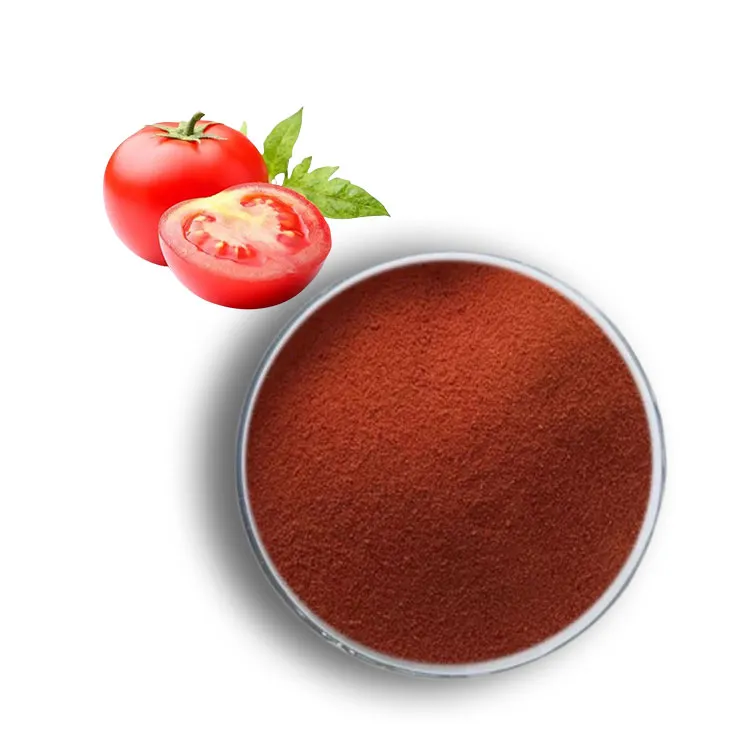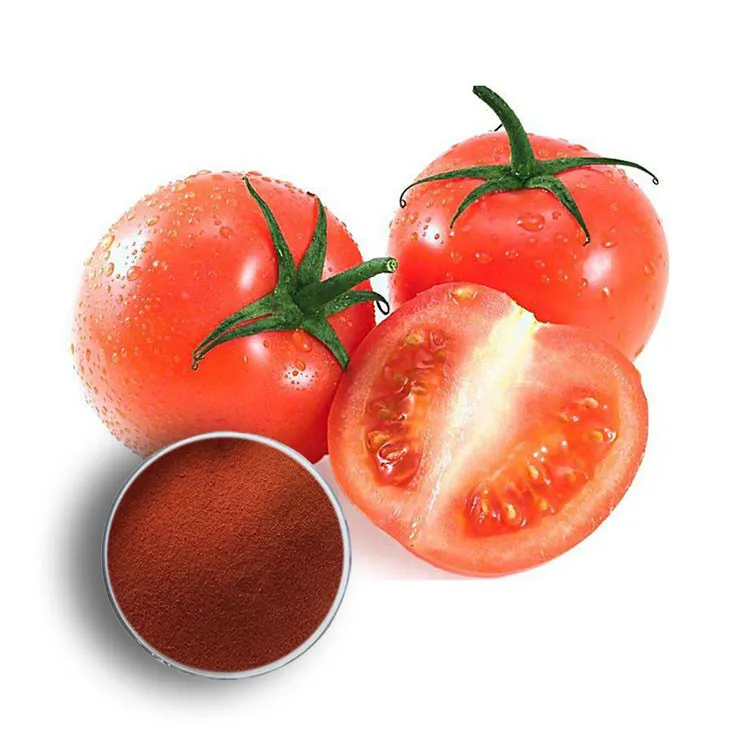- 0086-571-85302990
- sales@greenskybio.com
Lycopene Manufacturers from China.
2024-11-30

Introduction
Lycopene, a natural pigment and a powerful antioxidant, has been drawing increasing attention in the global market. It is widely used in various industries, including food, cosmetics, and pharmaceuticals. China, as a major global manufacturing hub, has become a significant force in Lycopene production. Chinese Lycopene manufacturers have their own characteristics and advantages, which have enabled them to occupy an important position in the international market.

Abundant Raw Materials
China's Rich Agricultural Resources
China is a large agricultural country with vast agricultural resources. Tomatoes, which are the main source of lycopene, are widely cultivated in many regions of China. The suitable climate and soil conditions in some areas provide favorable conditions for tomato growth. For example, in Xinjiang, a large province - level administrative region in China, the sunshine is sufficient and the temperature difference between day and night is large, which is very conducive to the accumulation of nutrients in tomatoes. This means that there is a large - scale and stable supply of tomatoes in China, ensuring a continuous source of raw materials for lycopene extraction.
Cost - Effective Supply of Raw Materials
Due to the large - scale cultivation of tomatoes in China, the cost of raw materials for lycopene production is relatively low. The large - scale planting can realize economies of scale in the process of tomato cultivation, including the purchase of seeds, fertilizers, and pesticides at a relatively low cost. Moreover, the transportation cost of tomatoes within China is also relatively controllable because of the relatively complete transportation network. This cost - effective supply of raw materials gives Chinese lycopene manufacturers an important advantage in terms of cost control at the very beginning of the production process.

Advanced Research and Development
Continuous Investment in R & D
Chinese lycopene manufacturers have recognized the importance of research and development in improving product quality and competitiveness. They have been continuously investing in R & D in recent years. By collaborating with scientific research institutions and universities, they are able to access the latest scientific research achievements and apply them to the production process. For example, some manufacturers have established long - term cooperation relationships with agricultural research institutes to jointly study the improvement of tomato varieties with higher lycopene content.
Improvement of Extraction Techniques
One of the key aspects of R & D is the improvement of extraction techniques. Chinese manufacturers are constantly exploring and innovating in this area. Supercritical Fluid Extraction Technology
Supercritical fluid extraction is an advanced technology that is being increasingly adopted by Chinese lycopene manufacturers. This technology uses supercritical fluids (such as carbon dioxide) as solvents. Compared with traditional extraction methods, it has several obvious advantages. First, it can achieve a higher extraction rate, which means that more lycopene can be extracted from the same amount of tomatoes. Second, it can effectively separate impurities, thereby significantly improving the purity of lycopene. Third, because carbon dioxide is a non - toxic and environmentally friendly gas, this technology has less environmental impact, which is in line with the current trend of environmental protection in the global manufacturing industry.
Quality Control and Standardization
With the development of R & D, Chinese manufacturers are also strengthening quality control and standardization in the production process. They have established strict quality control systems, from the selection of raw materials to the final product packaging. In the production process, various quality inspection methods are used to ensure that the lycopene products meet international quality standards. For example, high - performance liquid chromatography (HPLC) is often used to accurately measure the content and purity of lycopene.

Cost - Effectiveness
Lower Labor Costs
Compared with some Western countries, China has relatively lower labor costs. In the production process of lycopene, labor is an important factor. From the cultivation of tomatoes in the fields to the extraction and purification of lycopene in the factories, a large amount of labor is required. The lower labor cost in China enables manufacturers to reduce production costs at this level. For example, in the process of tomato harvesting, the relatively low labor cost in China can make the cost of raw material collection lower than that in some countries with high labor costs.
Production Cost Advantage
In addition to labor costs, other aspects of production costs in China are also relatively low. For example, the cost of energy such as electricity and water in China is relatively stable and at a reasonable level. The relatively complete industrial chain in China also contributes to cost reduction. In the production of lycopene, related auxiliary materials and equipment can be obtained at a relatively low cost in the domestic market. This comprehensive cost - effectiveness enables Chinese lycopene manufacturers to offer products at competitive prices in the international market.
Impact on the Global Market
The cost - effective lycopene products from China have a significant impact on the global market. They are highly attractive to global buyers, especially those in developing countries. These buyers can obtain high - quality lycopene products at a relatively low price, which helps to promote the wider application of lycopene in various industries around the world. At the same time, this also makes Chinese lycopene manufacturers face more opportunities and challenges in the international market. They need to continuously improve their competitiveness to maintain and expand their market share.
Challenges and Opportunities
Challenges
- Competition from International Manufacturers
Although Chinese lycopene manufacturers have certain advantages, they also face fierce competition from international manufacturers. Some well - established international companies may have stronger brand influence and more advanced marketing strategies. Chinese manufacturers need to continuously improve their brand building and marketing capabilities to enhance their international competitiveness.
- Regulatory Requirements
Different countries and regions have different regulatory requirements for lycopene products. Chinese manufacturers need to fully understand and comply with these regulations to ensure that their products can be smoothly sold in the international market. For example, in the European Union, there are strict regulations on the safety and quality of food additives, and Chinese manufacturers need to meet these requirements to enter the EU market.
- Technological Innovation Pressure
The field of lycopene manufacturing is constantly evolving, and new technologies and methods are emerging continuously. Chinese manufacturers need to keep up with the pace of technological innovation, continuously invest in R & D, and improve their production techniques to avoid being left behind in the international competition.
Opportunities
- Growing Global Demand
The global demand for lycopene is growing steadily. With the increasing awareness of health and the pursuit of natural products, lycopene, as a natural antioxidant, has broad application prospects in the fields of food, cosmetics, and pharmaceuticals. Chinese manufacturers can take advantage of this opportunity to expand their production scale and market share.
- Belt and Road Initiative
The Belt and Road Initiative provides new opportunities for Chinese lycopene manufacturers. Through cooperation with countries along the Belt and Road, Chinese manufacturers can expand their overseas markets, establish production bases overseas, and conduct in - depth cooperation in technology and trade. For example, some countries along the Belt and Road have rich agricultural resources but lack advanced manufacturing technology. Chinese manufacturers can cooperate with them to jointly develop the lycopene industry.
- E - commerce and Digital Marketing
The development of e - commerce and digital marketing has also brought new opportunities for Chinese lycopene manufacturers. Through e - commerce platforms, manufacturers can directly connect with global consumers, reducing intermediate links and costs. Digital marketing tools such as social media marketing can also help manufacturers to promote their products more effectively and enhance brand awareness.
Conclusion
China's lycopene manufacturers have made remarkable progress with their advantages in raw materials, research and development, and cost - effectiveness. They play an important role in the global lycopene manufacturing industry. However, they also face challenges such as competition from international manufacturers and regulatory requirements. By seizing opportunities such as growing global demand and international cooperation, and continuously improving their competitiveness through technological innovation and brand building, Chinese lycopene manufacturers are expected to maintain and expand their leading position in the global market in the future.
FAQ:
What are the main advantages of Chinese lycopene manufacturers?
Chinese lycopene manufacturers have several main advantages. Firstly, China has vast agricultural resources, and tomatoes, the main source of lycopene, are abundantly grown in many regions, ensuring a stable and cost - effective raw material supply. Secondly, they keep investing in R & D, improving extraction techniques for better purity and quality. Advanced technologies like supercritical fluid extraction are increasingly used. Finally, compared with some Western countries, they have relatively lower labor and production costs, enabling them to offer competitive - priced products in the international market.
How does China ensure a stable supply of raw materials for lycopene manufacturing?
China ensures a stable supply of raw materials for lycopene manufacturing through its vast agricultural resources. Tomatoes, which are the main source of lycopene, are widely grown in many regions of the country. This large - scale cultivation provides an abundant source of raw materials for lycopene extraction, thus ensuring a stable supply.
What role does research and development play in Chinese lycopene manufacturing?
Research and development plays a crucial role in Chinese lycopene manufacturing. Manufacturers are constantly investing in R & D to improve extraction techniques. By doing so, they can enhance the purity and quality of lycopene. For example, the adoption of advanced technologies such as supercritical fluid extraction not only increases the yield of lycopene but also reduces the environmental impact.
Why are Chinese - made lycopene products attractive to global buyers?
Chinese - made lycopene products are attractive to global buyers mainly because of their cost - effectiveness. Chinese manufacturers have relatively lower labor and production costs compared to some Western countries. This allows them to offer lycopene products at competitive prices in the international market, which is very appealing to global buyers.
How do Chinese lycopene manufacturers reduce environmental impact?
Chinese lycopene manufacturers reduce environmental impact by adopting advanced extraction techniques. For example, supercritical fluid extraction technology is increasingly being used. This technology is more environmentally friendly compared to some traditional extraction methods as it can reduce waste and energy consumption during the lycopene extraction process.
Related literature
- Lycopene Production and Its Applications in the Food Industry"
- "The Role of Lycopene in Cosmetics: A Review of Manufacturing and Quality"
- "Advances in Lycopene Extraction Technologies in China"
- ▶ Hesperidin
- ▶ citrus bioflavonoids
- ▶ plant extract
- ▶ lycopene
- ▶ Diosmin
- ▶ Grape seed extract
- ▶ Sea buckthorn Juice Powder
- ▶ Beetroot powder
- ▶ Hops Extract
- ▶ Artichoke Extract
- ▶ Reishi mushroom extract
- ▶ Astaxanthin
- ▶ Green Tea Extract
- ▶ Curcumin Extract
- ▶ Horse Chestnut Extract
- ▶ Other Problems
- ▶ Boswellia Serrata Extract
- ▶ Resveratrol Extract
- ▶ Marigold Extract
- ▶ Grape Leaf Extract
- ▶ blog3
- ▶ blog4
-
Organic Vitamin B9 Powder Factory.
2024-11-30
-
Chinese Dandelion Root Extract Factories.
2024-11-30
-
Bulk purchase of okra extract.
2024-11-30
-
Chinese melatonin factories.
2024-11-30
-
Certified organic kidney bean extract.
2024-11-30
-
Jujube Extract
2024-11-30
-
Soy Extract
2024-11-30
-
Aminolevulinic acid
2024-11-30
-
Yellow Pine Extract
2024-11-30
-
Fig Extract
2024-11-30
-
Senna Leaf Extract
2024-11-30
-
Diosmin
2024-11-30
-
Boswellia Serrata Extract
2024-11-30
-
Clove Powder
2024-11-30
-
Saffron Extract Powder
2024-11-30





















